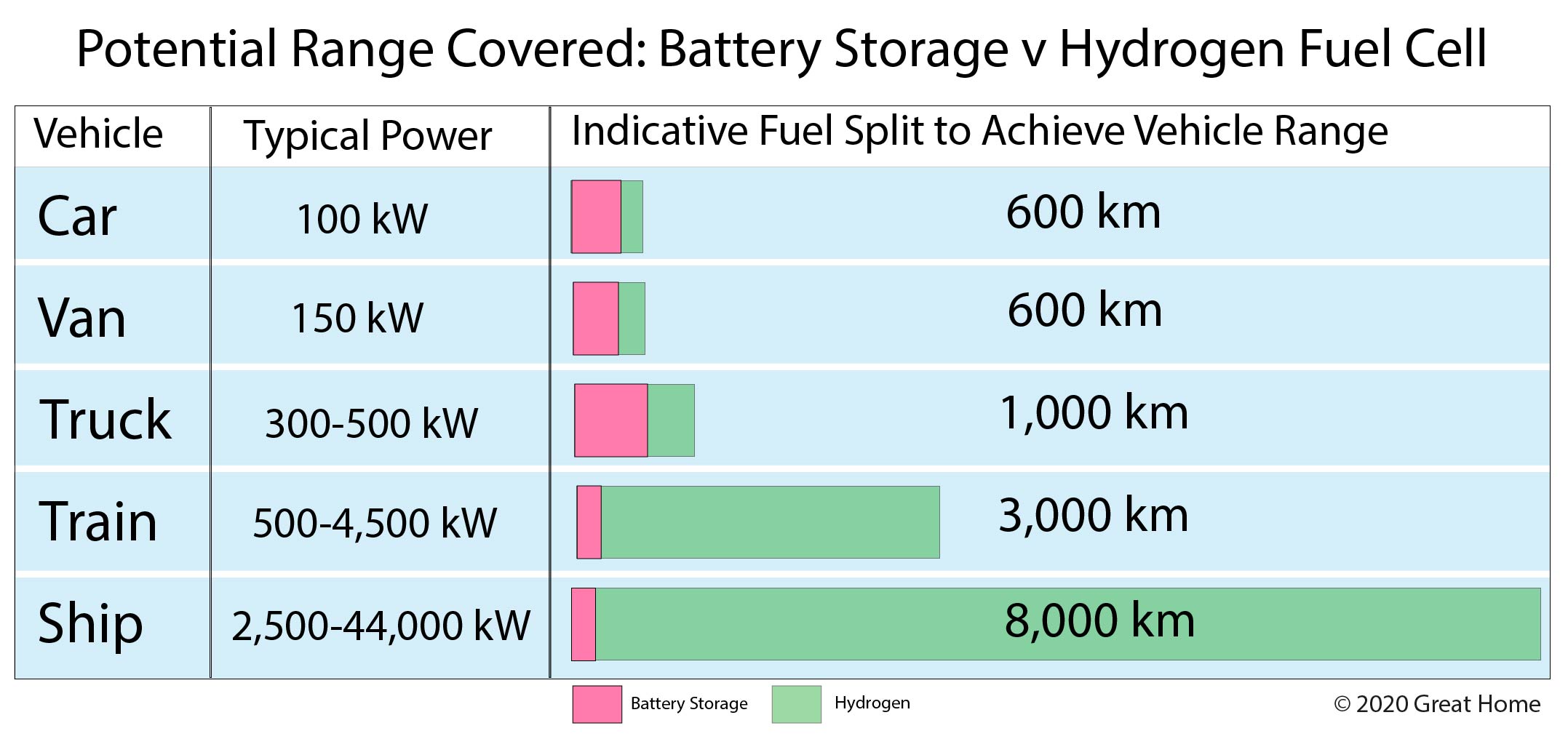Hydrogen Vs. Battery Buses: A European Transit Comparison

Table of Contents
Environmental Impact: Emissions and Lifecycle Analysis
The environmental impact of both hydrogen and battery buses is a crucial factor in their adoption. We need to consider both tailpipe emissions and the broader lifecycle assessment.
Greenhouse Gas Emissions
- Hydrogen Buses: Hydrogen fuel cell buses produce zero tailpipe emissions, emitting only water vapor. This makes them highly attractive for improving local air quality.
- Battery Buses: The tailpipe emissions of battery buses are zero, but their overall carbon footprint depends heavily on the source of electricity used to charge them. If the electricity comes from renewable sources like solar or wind power, the emissions are significantly lower. However, reliance on fossil fuel-based electricity negates the environmental benefits.
Lifecycle emissions encompass the entire process from raw material extraction and manufacturing to operation and eventual disposal. Producing green hydrogen, derived from renewable energy sources like electrolysis powered by wind or solar, significantly reduces the carbon footprint compared to grey hydrogen, produced from natural gas. A comprehensive lifecycle assessment reveals that while battery production has its own environmental costs (primarily mining and battery material processing), the overall lifecycle emissions can be lower than those of grey hydrogen buses, especially with a shift towards renewable electricity generation.
[Insert chart comparing lifecycle emissions of hydrogen and battery buses here – ideally showing green hydrogen vs. grey hydrogen comparisons.]
Air Quality Impact
Hydrogen buses offer a significant advantage in terms of local air quality. The only byproduct of their operation is water vapor, resulting in zero particulate matter and NOx emissions. This is a major benefit for urban areas struggling with air pollution.
Battery buses, while having zero tailpipe emissions themselves, contribute indirectly to air quality depending on the electricity source. If powered by fossil fuels, the electricity generation process releases pollutants, impacting air quality elsewhere. Therefore, the air quality benefits are maximized when paired with renewable energy sources.
Infrastructure Requirements and Costs
The deployment of both hydrogen and battery buses requires substantial infrastructure investments. The costs and feasibility differ significantly.
Refueling Infrastructure for Hydrogen Buses
Building a hydrogen refueling infrastructure is a complex and costly undertaking. It requires the construction of dedicated hydrogen refueling stations, including storage, compression, and dispensing equipment. The geographical distribution of these stations is currently limited, posing a challenge for widespread adoption, especially in sparsely populated areas. The hydrogen supply chain also needs significant development, adding to the complexity and costs.
Charging Infrastructure for Battery Buses
Deploying charging infrastructure for battery-electric buses is more straightforward and, in many ways, less expensive than building a hydrogen refueling network. Existing electricity grids can be leveraged, and various charging solutions exist:
- Overnight charging: Buses are charged overnight at depots.
- Opportunity charging: Buses receive short bursts of charge at strategically located stops along their routes.
- Depot charging: High-power charging facilities at bus depots.
While the initial investment for charging infrastructure is considerable, the existing electricity grid provides a significant advantage in terms of scalability and accessibility compared to the hydrogen refueling network.
Operational Performance and Economics
Operational performance and the total cost of ownership are key considerations when choosing between hydrogen and battery buses.
Range and Refueling/Charging Time
- Hydrogen Buses: Hydrogen buses generally offer a longer range compared to battery buses, reducing "range anxiety" – the fear of running out of fuel. Refueling time is relatively short, comparable to diesel buses.
- Battery Buses: Battery buses have a shorter range, requiring more frequent charging. Charging times vary significantly depending on the charging infrastructure and battery capacity. Opportunity charging can help mitigate this, but it requires a dense network of charging points.
Total Cost of Ownership (TCO)
The total cost of ownership (TCO) encompasses the purchase price, operating costs (fuel/electricity, maintenance), and infrastructure investments. Currently, battery-electric buses often have a lower initial purchase price than hydrogen buses. However, the long-term TCO can vary depending on factors like electricity prices, hydrogen production costs, and maintenance requirements. The costs associated with building and maintaining the refueling or charging infrastructure must also be factored into the TCO analysis.
Technological Maturity and Future Prospects
Technological advancements are continuously improving both hydrogen and battery technologies.
Technological Advancements in Both Hydrogen and Battery Technologies
Significant research and development efforts are underway to improve the efficiency, reduce the cost, and increase the longevity of both hydrogen fuel cells and batteries. Advancements in battery technology are leading to higher energy density, faster charging times, and longer lifespan batteries. Improvements in hydrogen production, storage, and fuel cell efficiency are also driving down costs and enhancing performance.
Future of Hydrogen and Battery Buses in European Cities
The future role of both technologies in European cities depends on many factors, including urban density, route lengths, political priorities, and the availability of renewable energy sources. In dense urban areas with shorter routes, battery-electric buses are likely to remain dominant due to their established infrastructure and lower initial costs. Hydrogen buses may be better suited for longer routes or areas where renewable energy sources are abundant, enabling green hydrogen production. Ultimately, a combination of both technologies may be necessary for a complete decarbonization of European public transport.
Conclusion
This comparison of hydrogen vs. battery buses highlights the complexities of choosing the optimal technology for European transit. While battery-electric buses currently benefit from more established infrastructure and potentially lower upfront costs, hydrogen fuel cell buses offer a compelling alternative with zero tailpipe emissions and potentially longer ranges. The best choice will depend on specific city contexts. Further research and investment in both technologies are crucial to achieving a truly sustainable future for European public transport. Ultimately, a balanced approach might see both hydrogen and battery buses playing significant roles in decarbonizing urban transportation. Continue your research on the specific needs of your region by searching for more information on hydrogen vs. battery buses, and consider the specific needs of your local context when making purchasing decisions.

Featured Posts
-
 Y And R February 11 Recap Understanding Nicks Confrontation With Victor
May 07, 2025
Y And R February 11 Recap Understanding Nicks Confrontation With Victor
May 07, 2025 -
 E Bay Faces Legal Repercussions Section 230 Doesnt Shield Banned Chemical Listings
May 07, 2025
E Bay Faces Legal Repercussions Section 230 Doesnt Shield Banned Chemical Listings
May 07, 2025 -
 Jazz Vs Rockets Conley And Edwards Step Up Without Gobert
May 07, 2025
Jazz Vs Rockets Conley And Edwards Step Up Without Gobert
May 07, 2025 -
 Nba Lyderiai Zaidzia Istoriniu Ritmu Ir Pakartoja Klubo Rekorda
May 07, 2025
Nba Lyderiai Zaidzia Istoriniu Ritmu Ir Pakartoja Klubo Rekorda
May 07, 2025 -
 La Lnh Regrette T Elle Sa Decision De Decentraliser Son Repechage
May 07, 2025
La Lnh Regrette T Elle Sa Decision De Decentraliser Son Repechage
May 07, 2025
